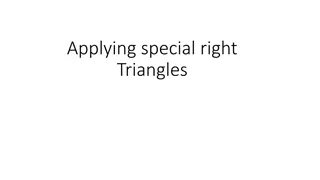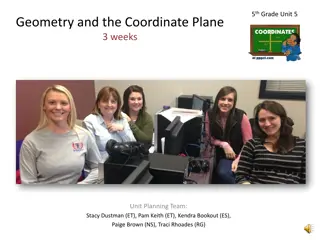Proofs in Coordinate Plane: Triangles & Quadrilaterals
Explore how to prove the properties of triangles and quadrilaterals utilizing coordinates, slopes, and distances in the coordinate plane. Learn about different types of triangles and quadrilaterals, key concepts like parallel and perpendicular lines, and the distance formula to establish geometric theorems.
Download Presentation

Please find below an Image/Link to download the presentation.
The content on the website is provided AS IS for your information and personal use only. It may not be sold, licensed, or shared on other websites without obtaining consent from the author.If you encounter any issues during the download, it is possible that the publisher has removed the file from their server.
You are allowed to download the files provided on this website for personal or commercial use, subject to the condition that they are used lawfully. All files are the property of their respective owners.
The content on the website is provided AS IS for your information and personal use only. It may not be sold, licensed, or shared on other websites without obtaining consent from the author.
E N D
Presentation Transcript
Lesson 6.5 Proving Properties of Triangles and Quadrilaterals Concept: Proofs in the Coordinate Plane EQs: -How do we prove the properties of triangles and quadrilaterals in the coordinate plane? (G.GPE.4) Vocabulary: Square, Rhombus, Rectangle, Parallelogram, Trapezoid, Isosceles Triangle, Right Triangle, Equilateral Triangle 1 4.2.4: Fitting Linear Functions to Data
Types of Triangles Types of Quadrilaterals Complete the Frayer Diagram with your knowledge of shapes and their properties. Properties of Triangles Properties of Quadrilaterals 2 6.1.2: Using Coordinates to Prove Geometric Theorems with Slope and Distance
Types of Triangles -Scalene -Isosceles -Equilateral -Right Types of Quadrilaterals -Square -Rectangle -Rhombus -Trapezoid Properties of Triangles -Three sides and three angles -Scalene No sides the same -Isosceles Two sides equal length -Equilateral All sides equal length -Right Right angle Properties of Quadrilaterals -Four sides and four angles -Square Equal & Parallel sides and four right angles -Rectangle Two sets of equal and parallel lines; four right angles -Rhombus - Two sets of equal and parallel lines -Trapezoid One set of parallel lines 3 6.1.2: Using Coordinates to Prove Geometric Theorems with Slope and Distance
Introduction In this lesson, we will use the distance formula and what we know about parallel and perpendicular lines to prove the properties of triangles and quadrilaterals in the coordinate plane. 4 6.1.2: Using Coordinates to Prove Geometric Theorems with Slope and Distance
Key Concepts to Recall: Formula to find slope: ?2 ?1 ?2 ?1 Parallel lines have the SAME slope and NEVER meet Perpendicular lines have the OPPOSITE RECIPROCAL slopes and meet at a ?? angle The Distance Formula: (x2-x1)2+(y2-y1)2 5 6.1.2: Using Coordinates to Prove Geometric Theorems with Slope and Distance
Guided Practice Example 1 A right triangle is defined as a triangle with 2 sides that are perpendicular. Triangle ABC has vertices A ( 4, 8), B ( 1, 2), and C (7, 6). Determine if this triangle is a right triangle. When disproving a figure, you only need to show one condition is not met. 6 6.1.2: Using Coordinates to Prove Geometric Theorems with Slope and Distance
Guided Practice: Example 1, continued 1. Plot the triangle on a coordinate plane. 7 6.1.2: Using Coordinates to Prove Geometric Theorems with Slope and Distance
Guided Practice: Example 1, continued 2. Calculate the slope of each side using the ? =?? ?? ?? ?? general slope formula, . = 6 2 8 1 4 Slope of AB = = 2 3 6 2 7 1 =4 =1 Slope of BC = 8 2 = 2 11 6 8 7 4 = 2 Slope of AC = 11 8 6.1.2: Using Coordinates to Prove Geometric Theorems with Slope and Distance
Guided Practice: Example 1, continued 3. Observe the slopes of each side. 1 The slope of is 2 and the slope of BC is . AB 2 The slopes of AB and BC are opposite reciprocals of each other which means they are perpendicular. 9 6.1.2: Using Coordinates to Prove Geometric Theorems with Slope and Distance
Guided Practice: Example 1, continued 4. Make connections. Right triangles have two sides that are perpendicular. Triangle ABC has two sides that are perpendicular; therefore, it is a right triangle. 10 6.1.2: Using Coordinates to Prove Geometric Theorems with Slope and Distance
Guided Practice Example 2 A square is a quadrilateral with two pairs of parallel opposite sides, consecutive sides that are perpendicular, and all sides congruent, meaning they have the same length. Quadrilateral ABCD has vertices A ( 1, 2), B (1, 5), C (4, 3), and D (2, 0). Determine if this quadrilateral is a square. 11 6.1.2: Using Coordinates to Prove Geometric Theorems with Slope and Distance
Guided Practice: Example 2, continued 1. Plot the quadrilateral on a coordinate plane. 12 6.1.2: Using Coordinates to Prove Geometric Theorems with Slope and Distance
Guided Practice: Example 2, continued 2. Show the figure has two pairs of parallel opposite sides. Calculate the slope of each side using the general m =y2-y1 x2- x1 slope formula, 13 6.1.2: Using Coordinates to Prove Geometric Theorems with Slope and Distance
Guided Practice: Example 2, continued Slope of AB = 1 1 =3 5 2 2 = 2 3 5 4 1 = 2 Slope of BC = 3 3 = 3 2 =3 0 3 2 4 Slope of CD = 2 = 2 = 2 0 2 2 1 Slope of AD = 3 3 14 6.1.2: Using Coordinates to Prove Geometric Theorems with Slope and Distance
Guided Practice: Example 2, continued 3. Observe the slopes of each side. The side opposite sides are the same. AB is . The slopes of these CD The side opposite is sides are the same. . The slopes of these AD BC This shows that the quadrilateral has two pairs of parallel opposite sides. 15 6.1.2: Using Coordinates to Prove Geometric Theorems with Slope and Distance
Guided Practice: Example 2, continued Sides and are consecutive sides and their slopes are opposite reciprocals. AB BC This is the case for sides BC and CD ; CD and AD; as well as AB and AD. Thus, the consecutive sides are perpendicular. 16 6.1.2: Using Coordinates to Prove Geometric Theorems with Slope and Distance
Guided Practice: Example 2, continued 4. Show that the quadrilateral has four congruent sides. Find the length of each side using the distance formula, . d = (x2-x1)2+(y2-y1)2 length of AB = (1-(-1))2+(5-2)2= (2)2+(3)2= 4+9 = 13 length of BC = (4-1)2+(3-5)2= (3)2+(-2)2= 9+4 = 13 17 6.1.2: Using Coordinates to Prove Geometric Theorems with Slope and Distance
Guided Practice: Example 2, continued length of CD = (2-4)2+(0-3)2= (-2)2+(-3)2= 4+9 = 13 length of AD = (2-(-1))2+(0-2)2= (3)2+(-2)2= 9+4 = 13 Thus, the lengths of all four sides are congruent. 18 6.1.2: Using Coordinates to Prove Geometric Theorems with Slope and Distance
Guided Practice: Example 2, continued 5. Make connections. Recall: A square is a quadrilateral with two pairs of parallel opposite sides, consecutive sides that are perpendicular, and all sides congruent. Quadrilateral ABCD has two pairs of parallel opposite sides, the consecutive sides are perpendicular, and all the sides are congruent. It is a square. 19 6.1.2: Using Coordinates to Prove Geometric Theorems with Slope and Distance
Guided Practice Example 3 Use the distance formula and slope to determine the shape of the figure. A ( 1,4) B (3,2) ( 4, 2) D (0, 4) C 20
Guided Practice: Example 3, continued 1. First find the slope of each side. Calculate the slope of each side using the general m =y2-y1 x2- x1 slope formula, 21 6.1.2: Using Coordinates to Prove Geometric Theorems with Slope and Distance
Guided Practice: Example 3, continued Slope of AB: (3) ( 1) = 2 = 1 (2) (4) 4 2 = 6 3 ( 4) (2) (0) (3) Slope of BC: = 2 2 = 1 A ( 2) ( 4) ( 4) (0) Slope of CD: = ( 1,4) 4 2 B (3,2) (2) (4) (3) ( 1)= 6 Slope of AD: = 2 3 ( 4, 2) D (0, 4) C 22 6.1.2: Using Coordinates to Prove Geometric Theorems with Slope and Distance
Guided Practice: Example 3, continued Slope of AB: 2 side. = 1 2. Observe the slopes of each The slopes for AB and CD are the same and BC and DA are the same; this makes these parallel lines! The slopes for AB and CD are the opposite reciprocal of BC and AD. This makes these lines perpendicular, which means they meet at a ?? angle! Slope of BC: = 2 = 1 Slope of CD: 2 Slope of AD: = 2 23 6.1.2: Using Coordinates to Prove Geometric Theorems with Slope and Distance
Guided Practice: Example 3, continued 3. Find and observe the side lengths of the quadrilateral. Find the length of each side using the distance formula, . d = (x2-x1)2+(y2-y1)2 24 6.1.2: Using Coordinates to Prove Geometric Theorems with Slope and Distance
Guided Practice: Example 3, continued The length from A to B is: A ( 1,4) B (3,2) ( 4, 2) D 4.47 20 (0, 4) C 25 6.1.2: Using Coordinates to Prove Geometric Theorems with Slope and Distance
Guided Practice: Example 3, continued The length from B to C is: A ( 1,4) B (3,2) ( 4, 2) D 6.71 45 (0, 4) C 26 6.1.2: Using Coordinates to Prove Geometric Theorems with Slope and Distance
Guided Practice: Example 3, continued The length from C to D is: A ( 1,4) B (3,2) ( 4, 2) D 4.47 20 (0, 4) C 27 6.1.2: Using Coordinates to Prove Geometric Theorems with Slope and Distance
Guided Practice: Example 3, continued The length from B to C is: A ( 1,4) B (3,2) ( 4, 2) D 6.71 45 (0, 4) C 28 6.1.2: Using Coordinates to Prove Geometric Theorems with Slope and Distance
Guided Practice: Example 3, continued Distance of AB 4.47 4. Observe the distances of each side. The distances of AB and CD are both 4.47 and the distances of BC and DA are both 6.71. Distance of BC 6.71 Distance of CD 4.47 Distance of AD 6.71 This shows us that the opposite sides are of equal length. 29 6.1.2: Using Coordinates to Prove Geometric Theorems with Slope and Distance
Guided Practice: Example 3, continued 5. Make connections. A rectangle and a square are both quadrilaterals with two pairs of parallel opposite sides and consecutive sides that are perpendicular A rectangle is a quadrilateral with two pairs of opposite sides of equal length. Quadrilateral ABCD has two pairs of parallel opposite sides, the consecutive sides are perpendicular, and the opposite sides are of equal length. This shape is a rectangle. 30 6.1.2: Using Coordinates to Prove Geometric Theorems with Slope and Distance
Guided Practice You Try! What shape is formed by connecting the points (1,0),(3,2) and (5,0)? Prove your answer using your knowledge of parallel and perpendicular lines and the distance and midpoint formulas. 31
Since it is a three sided figure, we can eliminate the possibility of a quadrilateral. Label each point and find the slope of each side: KL = 2= 1 LM =0 4= 0 MK = 2 2= 1 Notice that none of the slopes are the same or opposite reciprocals. This means there are no parallel or perpendicular lines. 2 K (3,2) M L (1,0) (5,0) 32 6.1.2: Using Coordinates to Prove Geometric Theorems with Slope and Distance
Find the length of each side: KL 2.23 LM = 4 MK 2.23 K Since there were no parallel or perpendicular lines and since two sides are equal, we know this must be an isosceles triangle. (3,2) M L (1,0) (5,0) 33 6.1.2: Using Coordinates to Prove Geometric Theorems with Slope and Distance
Use the words listed below summarize the lesson for today in a few sentences. Distance Length Parallel Perpendicular Slope Same Side Opposite Consecutive 34 6.1.2: Using Coordinates to Prove Geometric Theorems with Slope and Distance























